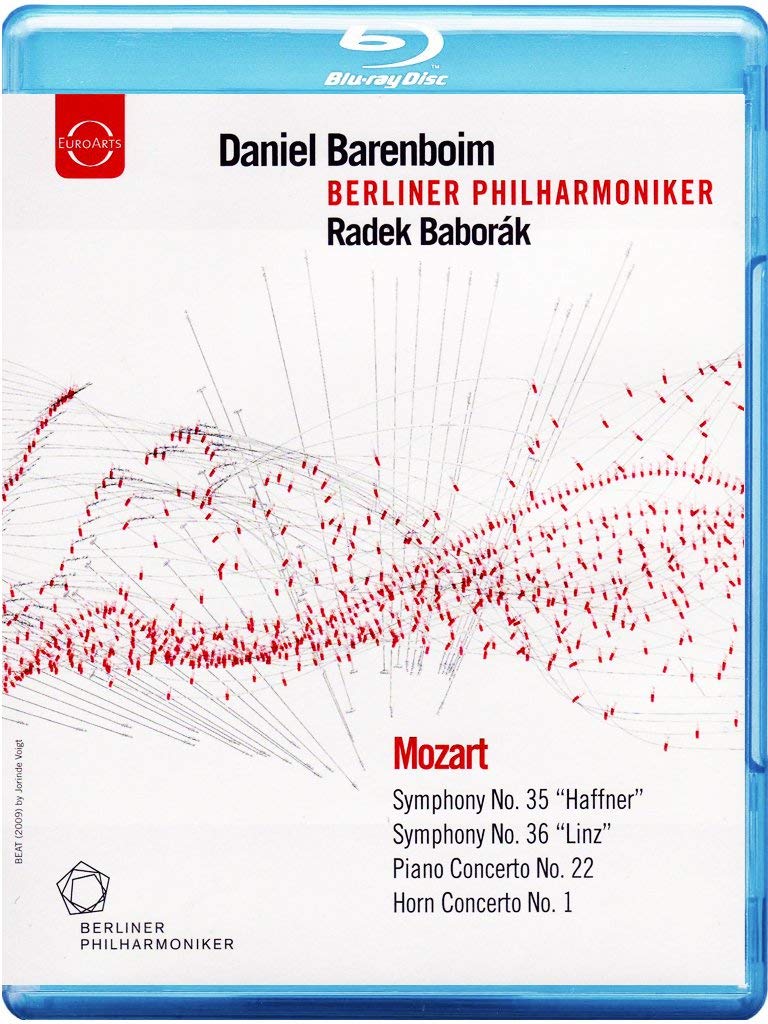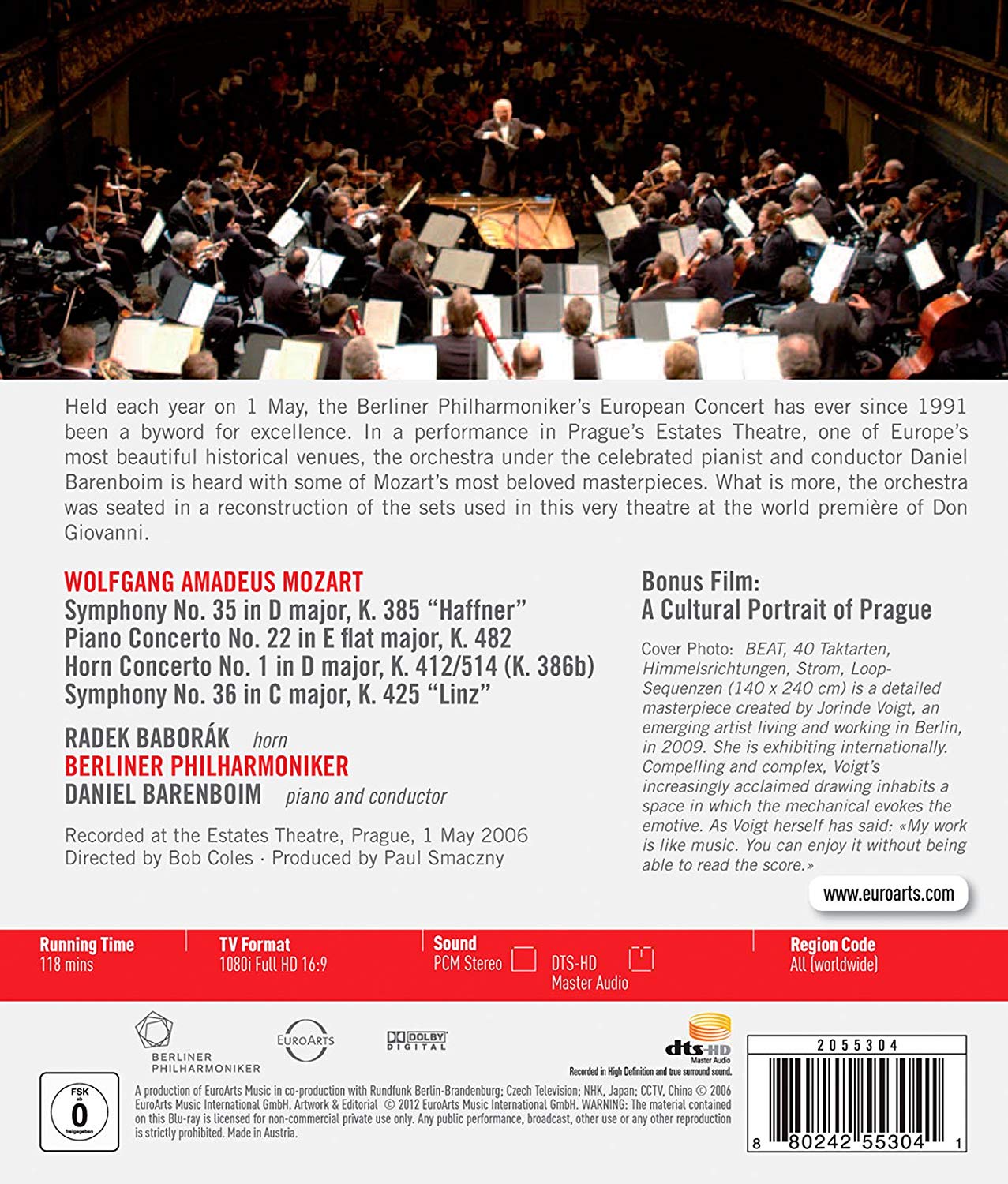

2006 Europakonzert: Mozart Masterpieces (our name) concert. Daniel Barenboim conducts the Berliner Philharmoniker at the 2006 Europakonzert. This is the annual May 1st concert given by the Berlin Philharmoniker each year in a special venue, usually in a different European city. In 2006 the venue was the Theater of the Estates in Prague—the theater in which Mozart conducted the premier of Don Giovanni. For this performance the orchestra sits on a stage that is a reconstruction of the sets used in the first production of Don Giovanni. Grade: B
The program:
Symphony No. 35 “Haffner”
Symphony No. 36 “Linz”
Horn Concerto No. 1 (Radek Baborák horn soloist)
Piano Concerto No. 22, K482 (Barenboim piano soloist)
There is also a SD bonus film, A Cultural Portrait of Prague.
Directed for TV by Nyika Jancsó; edited by Steffen Herrmann; Audio Producer was Georg Obermayer; Balance Engineer was Toine Mertens; produced by Paul Smaczny. Released 2012, disc has 5.1 dts-HD Master Audio sound. I give the Grade: B to the whole disc. See the discussion below of individual grades for the 4 numbers on the program.
I understand this is the only public theater left standing where Mozart performed. (There are, I think, many venues in palaces and private homes where Mozart appeared.) The Prague Estates Theater (or National Theater) is a jewel box with 228 orchestra seats and room for 405 more in the 5 balconies. Subject title has about 20 awesome architectural shots worked into the music performed. This is what the theater looked like on the first opening night of Don Giovanni! Everywhere there are candelabra with flame-shaped electric lights. But when Mozart worked there, these were real burning candles! How did they get enough light on the scores for the musicians to read the notes?
This was also the theater where Le nozze di Figaro and La clemenza de Tito were first performed. So it was fitting for the Berliner Philharmoniker to do an all-Mozart program for their May Day Prague visit. (The SD bonus film, A Cultural Portrait of Prague, is only mildly-interesting, but it does have a couple of exterior shots of the Estates Theater.)
This concert was recorded in May, 2006, before any fine-art HDVD had been published. The video resolution is soft by today's standards, but it is HD with nice color balance. The sound quality is not up to audiophile quality, but it is fine for something recorded for DVD in 2006 and then presented in Blu-ray with dts-HD Master Audio output.
So now we must turn our attention to video content. As we have noted many times on this website, most of the symphony concerts presented so far in Blu-ray suffer from some degree of the illness called "DVDitis." What causes this illness? Briefly, the low resolution of DVD means that the cameramen must get as many close-up shots as possible and avoid long-distance shots that will look fuzzy in DVD. But for high-definition display, the cameramen can make whole orchestra shots and other long-range shots that will allow the TV viewer to see things in a manner similar to watching a show live. It's impossible to make a large symphony video that will look great on both DVD and HDVD. When a DVD-type show is foisted off on Blu-ray, the result is bad video content, even if the resolution is better.
The larger the symphony orchestra being recorded, the more acute the attack of DVDitis will likely be. But when, as with subject title, we have a relatively shall chamber orchestra to record, one can hope for a recording that might look good in both DVD and HDVD or that the video director might make two different recordings for presentation later in the both formats. So lets see how Smaczny, Jancsó, Herrmann, and Mertens did with the four numbers in this show:
1. Symphony No. 35. I counted 171 video cuts for a average duration of about 7 seconds per video angle. This is about twice as fast as the stately pace of 10 to 15 seconds per angle that I note in such fine HDVD recordings as the Bruckner Symphony No. 9 and Schumann Piano Concerto. Other DVDitis symptoms found are too many (cheap and easy) conductor shots (especially 15 conductor shots made over the backs of the orchestra members), 23 ridiculous instrument only shots (all instruments being played by the best musicians in the world!), and numerous part-section shots made from careless and unflattering angles (that make the musicians look bad). On the other hand, there are about 22 whole-orchestra shots (all welcome even if they are all too, too short). And there a couple of really pretty shots that stand out: (1) we get the see the 1st violins play an entire segment in a coherent manner at about 06:57 and (2) we get a beautiful shot of all the usually-ignored 2nd violins at about 15:17. (When it comes to these symphony recordings, we have to rejoice and gobble up any crumbs that come our way.) Grade for Symphony No. 35: C+.
2. Piano Concerto No. 22. It's hard for the cameramen to waste our time on conductor shots when, as here, the conductor is spending most of his time playing the piano. Still, DVD habits are hard to break, and we do get 13 almost completely worthless shots of Barenboim waving his arms, including 6 made over the backs of his players. And there are still 15 mysterious instrument-only shots to drag down the presentation. But those will be our only complaints for this number. There are 23 whole-orchestra shots + 8 nice part-orchestra views. I counted 96 video cuts of Barenboim playing the piano. But many of these cuts are strung together in a more-or-less seamless way. So the pace of the video seems slowed down to something like 10 to 12 seconds for the average video segment. This pace is much more relaxing and pleasant than the usual symphony DVD. The sane pace, together with 7 impressive architectural shots make this part of the program most enjoyable to watch in the home theater. Grade for Piano Concerto No. 22: A-.
3. Horn Concerto No. 1. This short work has a pace of about 11 seconds per video cut (counting as a single cut any continuous video segment of the horn soloist). There are just a handful of shots of instruments only or the conductor. The audience really loved this number because soloist Padek Baborák is Czech. He graciously soaked up adulation and beamed proudly at the bouquet he received of 3 bright red daisies. Grade for Horn Concerto: A-.
4. Symphony No. 36. Back to rampant DVDitis with a fast pace of 5.9 seconds per video cut, 50 conductor shots (22 over the backs of musicians), 30 instrument-only shots, etc. Grade for Symphony No. 36 :C+.
Summary: Combining the 4 grades for the performance, I would give the whole disc a B-. But because of the beautiful shots of the theater, I mark this up to a B overall.
OR
